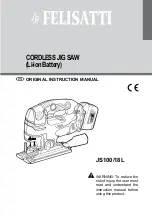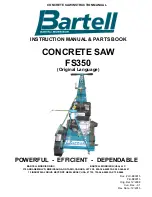
8 –
English
SAFETY INSTRUCTIONS
Basic working techniques
•
Always start by cutting a pilot cut. This is done by feeding
the blade 3-7 cm (1,2”-2,8”). Now make the pilot cut. The
cut should not be made at maximum speed, but with care
in order to obtain a straight cut and with that a basis for the
next cut. The cutting arm allows blades up to 1 000 mm
(40”) to be used as the start blade. It is, however,
recommended to start cutting with an 800 mm (31.5”)
blade.
•
When the pilot cut is finished, a deeper cut can be made.
The depth of these is determined from instance to
instance and depends on factors such as hardness of the
concrete, existence of reinforcing bar, etc. Max. diameter
of the blade for deeper cuts is 1,200 mm (47”).
•
If you change blades to cut deeper in the same cut, make
sure the thickness of the blade matches the width of the
groove.
•
Let the machine work without forcing or pressing the
blade.
•
Firmly secure or anchor concrete blocks before cutting.
The heavy weight of cut material can cause extensive
damage if it is not moved under controlled conditions.
Cutting of blocks
•
First make the lower horizontal cut. Now make the upper
horizontal cut. Finish with the two vertical cuts.
•
If the upper horizontal cut is made before the lower
horizontal cut, the work piece will fall on the blade and jam
it.
•
When making the last cut, the saw should be mounted on
an adjacent fixed wall.
•
As the rail is symmetrical, the saw unit can be turned to
make a new cut on the other side of the rail. In this way a
cut piece is obtained that is in an easily handled size,
making it easier to remove from the workplace.
•
Since the blade rotation direction can be selected, the
water spray from the blade can also be selected
regardless of how the saw is turned on the rail.





































